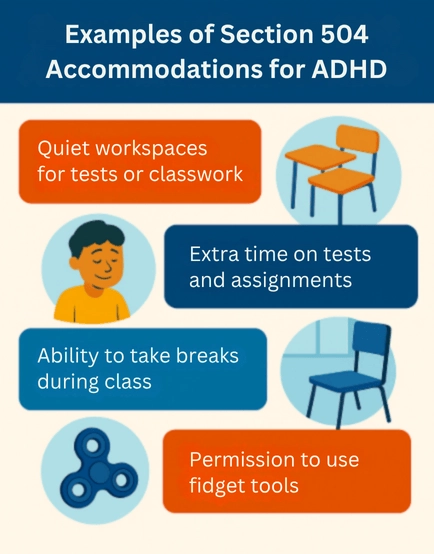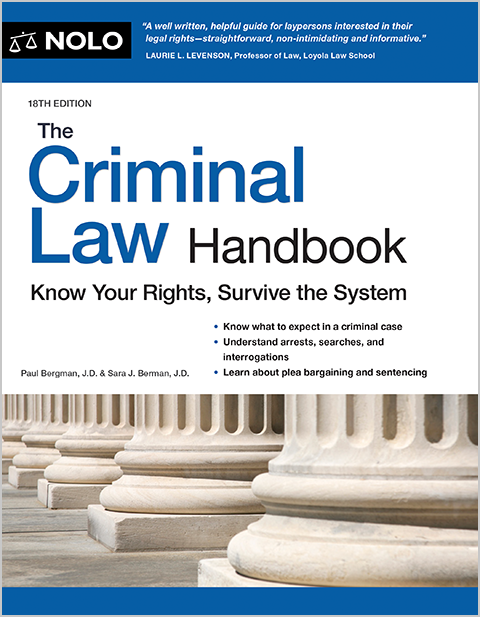Schools are required to provide Section 504 plans to children with physical or mental disabilities. Learn about eligibility, requirements, and how to request a 504 plan.
Section 504 requires schools to develop 504 plans to provide children with mental and physical disabilities the same access to educational programs and services that other children have. Section 504 refers to a section of the federal Rehabilitation Act (29 U.S.C. § 794), a disability rights law separate from IDEA. (IDEA is the act that requires schools to provide IEP plans to students with disabilities.)
Section 504 requires all agencies that receive federal financial assistance to provide access to individuals with disabilities. Specifically, Section 504 requires school districts to ensure that children with disabilities have access to educational programs and services through physical modifications (such as ramps, widened doorways, and accessible restrooms and other school facilities) and intangible modifications (such as testing accommodations and assistance from interpreters, note takers, and readers).
What Is a Section 504 Plan?
A Section 504 plan is a written document that outlines the accommodations and supports a student with a disability needs to access education in a public school setting.
In addition to requiring that all children have access to classrooms, bathrooms, recreational areas, and so on, Section 504 in schools requires that students with disabilities receive an appropriate education. If your school finds that your child is eligible for help under Section 504, the school must develop a written plan describing the modifications, accommodations, and services your child will receive.
A Section 504 plan for students who qualify should include accommodations to take care of:
- health issues
- supplemental services such as speech or occupational therapy
- classroom aides, or
- a separate special education environment.
Like an IEP, the Section 504 plan must be individually tailored to meet your child's needs. Many schools have developed a standard form for Section 504 plans; ask your school if it has one. Sometimes 504 plans are called "accommodation plans."
Who Is Eligible for a Section 504 Plan?
Children may qualify for a Section 504 plan even if they're not eligible under IDEA. A student is eligible for a Section 504 plan if they have a physical or mental impairment that substantially limits one or more "major life activities," or if they have a record of an impairment, or if they're regarded as having an impairment.
What Are Major Life Activities?
The Americans with Disabilities Act (ADA) defines major life activities to include walking, seeing, eating, hearing, speaking, breathing, learning, working, reading, thinking, communicating, practicing self-care, and performing manual tasks. The ADA Amendments Act of 2008 (ADAAA) clarified that major bodily functions (such as immune, digestive, bowel, bladder, neurological, brain, respiratory, circulatory, endocrine, and reproductive functions) also count as major life activities. (42 U.S. Code § 12102.)
Does Section 504 List Conditions That Qualify for Section 504 Protection?
No particular medical condition automatically qualifies a child for a Section 504 plan. That's because most medical conditions can range in severity. For instance, a child may have a diagnosis of ADHD, diabetes, dyslexia, food allergies, asthma, cerebral palsy, or a specific learning disability, but the condition might not limit the child's major life activities.
In 2024, the federal regulations that interpret Section 504 were updated to include examples of medical conditions that may qualify for Section 504 protection. The new regulation (Nondiscrimination on the Basis of Disability in Programs Receiving Federal Financial Assistance) lists examples of conditions that can qualify for Section 504 protection, including visual and hearing impairments, cerebral palsy, cosmetic disfigurement, epilepsy, muscular dystrophy, multiple sclerosis, diabetes, intellectual disability, learning disabilities, ADHD, and long COVID (when the condition substantially limits a major life activity).
The new rule also calls for the definition of disability to be applied broadly, meaning that children with serious medical conditions should be given the benefit of the doubt that Section 504 applies to them. (45 C.F.R. § 84.4.)
Section 504 Plan Requirements
A Section 504 plan should include details on the following:


Placement of Student
Section 504 requires that schools place a student with physical or mental disabilities in a mainstream classroom to the extent possible. Only if the school can show that the student can't receive a satisfactory education when surrounded by children without disabilities, even with the use of supplementary aids and services, is the school allowed to remove the child from a mainstream classroom. (34 C.F.R. § 104.34.)
Testing Set-Up
Section 504 requires tests to be selected and administered to ensure that students with impaired sensory, manual, or speaking skills are not at a disadvantage. Schools need to attempt to make sure that test results accurately demonstrate the student's knowledge or aptitude, rather than reflecting the student's impaired sensory, manual, or speaking skills. (34 C.F.R. § 104.35.) For more information, see Nolo's article on testing accommodations.
Other Accommodations
Students with medical conditions may need a Section 504 plan to give them permission to disregard certain school rules and guidelines in order to manage their condition. For instance, a student with Type 1 diabetes may need to be able to carry insulin and a testing kit for blood glucose levels at all times. The American Diabetes Association offers a comprehensive sample Section 504 plan.
Here are some other potential accommodations that a Section 504 plan can include:
- modified assignments or adjusted homework workload
- permission to type assignments instead of handwriting them
- preferential seating (for example, at the front of the class or near an aisle)
- access to assistive technology (for example, notetaking apps or speech-to-text software)
- extended time for transitions or bathroom breaks
- exemption from physical activities when medically necessary, and
- permission to leave class for medical needs or visit the nurse as needed.
How to Request a 504 Plan
The first step in getting assistance is to "refer" your child for Section 504 services—this simply means asking the school to consider your child's 504 plan eligibility. Some school districts automatically consider children who are found ineligible for an IEP plan for Section 504 services; if yours doesn't, request—in writing—that it do so.
Once a child has been referred for evaluation, the school will evaluate your child's eligibility. It will look at:
- whether your child has a physical or mental impairment
- whether your child's impairment substantially limits the child's "major life activities," including learning, and
- what types of accommodations your child needs in order to receive a free and appropriate public education (FAPE).
What's the Difference Between Section 504 vs. IDEA?
The eligibility, procedural, and other requirements of Section 504 are different from IDEA's requirements. Section 504 is a civil rights anti-discrimination law that removes barriers to participation, while IDEA provides funds for special education to provide additional services.
To be eligible for an IEP plan under IDEA, a student must have a disability or impairment that negatively affects his or her performance at school. In contrast, Section 504 requires that a child have an impairment that limits a major life activity. While not all children who are eligible for Section 504 plans are eligible for IEP plans (they may be performing at grade level), all children who are eligible for an IEP plan are protected under Section 504.
Note: Section 504 is enforced by the Office for Civil Rights (OCR), a component of the U.S. Department of Education. IDEA is administered by the Office of Special Education and Rehabilitative Services (OSERS), also a component of the U.S. Department of Education, in combination with state educational agencies.
Are Private Schools Subject to Section 504?
Section 504 applies to private schools that receive any federal financial assistance, including grants from nonprofit organizations that receive money from the federal government. Any school, including private religious schools, that receives federal support for free or reduced lunch or milk programs or through a voucher program must follow Section 504. In addition, the Americans with Disabilities Act (ADA) extends the protections of Section 504 to private schools that don't receive any financial assistance.
Under Section 504, private schools can't exclude a student with disabilities if the student can receive an appropriate education with minor accommodations. In addition, a private school can charge higher fees to a student with special needs only if the school would have a substantial increase in costs due to providing that child with an appropriate education.
Lastly, Section 504 applies to charter schools just as it does to regular public schools.
How to Make a Section 504 Complaint
If you're unhappy with your child's Section 504 plan or decisions made around it, first talk to your child's principal informally and try to work it out. If you still feel your child's rights to a free and appropriate education aren't being met, you can file an informal written complaint. Give the complaint to the principal and, if necessary, the district superintendent or the district's "Section 504 designee."
If appropriate action still isn't taken, you can hire a disability rights lawyer or an education lawyer to help. (Read Nolo's article about hiring an education attorney.)
An attorney can help you file an official complaint with the Office for Civil Rights. OCR investigates complaints of disability discrimination under Section 504 and may require the school to make changes if violations are found. You need to file your complaint within six months of the discrimination. (Learn more about the OCR complaint process.)
As discussed below, recent office closures may result in delays in getting a response or resolution to your complaint.
Current Legal Threats to Section 504
An ongoing court case and changes to the Department of Education under the Trump Administration may upend enforcement of the legal protections provided by Section 504.
States' Lawsuit in Texas
The most significant threat to Section 504 is a pending lawsuit, Texas v. Becerra. After the Biden Administration finalized the new regulations discussed above, 17 states filed a lawsuit challenging the federal government's authority to enforce Section 504 protections. The states objected to the language that broadened the definition of disability—because they worried it would include gender dysphoria—and that required integration of students with disabilities into mainstream classrooms to the extent possible.
The new rules don't include gender dysphoria in the list of conditions that could qualify for Section 504 protection, but they do refer to a Fourth Circuit case, Williams v. Kincaid (45 F.4th 759 (4th Cir. 2022)), which concluded that gender dysphoria can be a disability under Section 504 and the ADA. Separately, the new regulations do explicitly exclude homosexuality and bisexuality from the definition of disability.
Originally, the states' lawsuit sought to declare Section 504 unconstitutional in its entirety, which could have ended disability protections for millions of students. After facing significant backlash from disability advocates, the states withdrew their constitutional challenge, but they continue to challenge the new rules.
Federal Enforcement Capacity Severely Reduced
In March 2025, President Trump issued an executive order directing the closure of the U.S. Department of Education. Following this order, the workforce of the Office of Civil Rights (OCR) has been substantially reduced and most, but not all, of the regional offices of the OCR have closed. These changes substantially affect the ability of the OCR to enforce Section 504.
School districts, teachers' unions, parents, and advocacy groups have challenged these changes, and a federal judge issued a preliminary injunction. However, the Trump Administration has asked the Supreme Court to allow the layoffs and closures to proceed. The Supreme Court is expected to weigh in by July 21, 2025 as to whether the executive branch can dismantle the Department of Education without Congressional approval. Check back here for details.
Learn More
You can learn more about protecting your child from discrimination for a disability or health-related condition in Nolo's article on disability discrimination at school.

